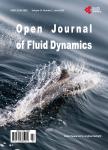Numerical Optimization of Pressure Force from Multiple Jets Impinging on a Moving Curved Surface for Industrial Drying Machines
Numerical Optimization of Pressure Force from Multiple Jets Impinging on a Moving Curved Surface for Industrial Drying Machines作者机构:Institute for Energy Research Ostwestfalen-Lippe University of Applied Sciences and Arts Lemgo Germany Research Institute of Education Ahvaz Iran Institute for Multiphase Processes Leibniz University Hannover Hannover Germany
出 版 物:《Open Journal of Fluid Dynamics》 (流体动力学(英文))
年 卷 期:2021年第11卷第4期
页 面:192-209页
学科分类:080704[工学-流体机械及工程] 080103[工学-流体力学] 08[工学] 0807[工学-动力工程及工程热物理] 0801[工学-力学(可授工学、理学学位)]
主 题:Multiple Jets Pressure Force Surface Motion Surface Curvature CFD Optimization
摘 要:Jet force on the surface is typical for impinging jets towards the surface and it is very important in drying applications for force-sensitive surfaces. The designer should optimize the design parameters of industrial drying equipment to achieve minimum pressure force between multiple jets and a moving curved surface. SST k-ω turbulence model is used to simulate a real geometry for industrial drying applications. The SST k-ω turbulence model succeeded with reasonable accuracy in reproducing the experimental results. The jet to surface distance, jet to jet spacing, jet inlet velocity, jet angle, and surface velocity are chosen as the design parameters. For the optimization of the impinging round jet, the pressure force coefficient on the moving curved surface is set as the objective function to be minimized. The SHERPA search algorithm is used to search for the optimal point from the weighted sum of all objectives method. One correlation is developed and validated for the pressure force coefficient. It is found that the pressure force coefficient is highly dependent on the nozzle to surface distance and jet angle but relatively insensitive to jet inlet velocity, jet to jet spacing, and surface velocity. The minimum pressure force coefficient correlates with a high value of nozzle to surface distance (tenfold diameter in this analysis) and a low value of the jet angle (40? in this analysis). The agreement in the prediction of the pressure force coefficient between the numerical simulation and developed correlation is found to be reasonable and all the data points deviate from the correlation approximately 8% on average.



